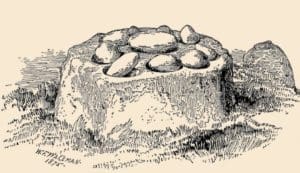Samurai and Shogun: Tracing Japan’s Warrior Paths Through Feudal History

Updated On: April 15, 2024 by Yasmin Elwan
Feudal Japan was an era dominated by the power and intrigue of the samurai and shogun. These warriors and leaders weren’t just military entities; they were also pivotal social figures who shaped Japan’s history. The samurai, with their strict ethical code known as bushido, exemplified ideals of honour and discipline. As a warrior class, their influence extended beyond the battlefield, shaping the culture and political landscapes of the time.

At the zenith of this warrior hierarchy was the shogun, the military dictator whose authority eclipsed even that of the emperor in certain periods. Samurai served these powerful rulers, governed by a complex social structure that ensured their prominence in Japanese society. From the earliest rise of militaristic clans to the eventual decline of samurai dominance, the intricate tapestry of these warriors’ stories provides a fascinating glimpse into Japan’s past.
Rise of the Samurai
Before Japan’s warrior class became the revered samurai, there was a significant transformation of power and social structure within the country.
From Clans to Warrior Class
In the tapestry of Japan’s history, the ascension of the samurai is a colourful thread woven through centuries of conflict and cultural evolution. Initially, bushi, or warriors, were simply part of the broader aristocracy that served in the imperial armies. However, over time, the increasing need for military skill and discipline led to the rise of the samurai as a distinct class.
From the Heian period onwards, power began to shift from the court to the provinces, where clans like the Minamoto and the Taira became instrumental in asserting military dominance. This period, known today as the rule of the shoguns, was characterised by the samurai serving their lords with both martial prowess and, at times, political counsel.
The Genpei War (1180-1185), a pivotal conflict between the two dominant clans, the Minamoto and the Taira, culminated in the establishment of the first shogunate under Minamoto no Yoritomo. The war signified not only the supremacy of the Minamoto clan but also the transition from a court-dominated government to a warrior-led administration.
As the power of these clans increased, so did the importance of the warrior class, solidifying the samurai’s role in Japan’s social fabric. The very essence of the samurai blended military strength with the adherence to the bushido code, which extolled virtues such as loyalty, honour, and discipline.
One of the more sombre aspects of the samurai code was seppuku, or ritual suicide. This act was seen as the ultimate form of taking responsibility for one’s actions or failures and was a stark testament to the serious nature of honour and duty within the samurai ethos.
The rise of the samurai as a warrior class reshaped Japan’s political and social landscape—setting the stage for centuries of samurai influence and the establishment of a military government that would endure until the modern era.
Samurai Under Shogunate Rule
In the tapestry of Japan’s history, the role of samurai under the various shogunates reveals a profound evolution of military and social structures. This section traces the journey of samurai warriors through pivotal periods of shogunate rule.
Kamakura Period
The Kamakura Shogunate, established by Minamoto no Yoritomo in the late 12th century, marks the inception of shogunate governance wherein the samurai class played a critical role. These were times when the Bakufu, Japan’s military government, operated from Kamakura, setting a precedent for samurai serving not just as warriors but also as administrators within a feudal system. The setup centred around shoen, or private estates, which were managed and protected by the samurai for various rewards, laying the foundation of a socio-political order that persisted through the ages.
Muromachi Period
Transitioning to the Muromachi Period, Ashikaga Takauji established the Ashikaga Shogunate in Kyoto, heralding an era that further stratified the feudal system. However, this was also an epoch of internal strife, where the power dynamic between the emperor and the shogunate fluctuated. The samurai were often entangled in these power struggles, influencing politics at both the provincial and national levels. Despite the political turmoil, Kyoto flourished culturally, deeply affecting the lives and ideals of the samurai class.
Edo Period
In stark contrast, the Edo Period was marked by long-standing peace under the rule of the Tokugawa Shogunate, with its bakufu based in Edo, modern-day Tokyo. This era witnessed the rigid formalisation of the class system, with the samurai positioned at the apex. Their swords became more symbolic than utilitarian, and the Bushido code emphasised moral conduct, loyalty, and honour above martial prowess. During this period, the samurais’ roles transitioned significantly from warriors to bureaucrats and scholars, reflecting the shogunate’s need for a stable governance structure that discouraged warfare and favoured bureaucratic control.
Warfare and Military Tactics
In our exploration of Japan’s feudal past, we focus on the meticulous development of samurai warfare, examining the intricate details of both their armoury and the evolution of military strategies.
Weapons and Armour
Samurai warriors were equipped with a variety of weapons, each serving a distinct purpose in battle. The katana, known for its sharpness and strength, was the samurai’s primary weapon, often accompanied by a shorter sword, the wakizashi. The bow, highly revered in samurai culture, was not just a weapon but an embodiment of their martial spirit. Armour was a critical part of a samurai’s battle gear, designed to be both protective and flexible. The elaborate armour included the dō or chest armour, kabuto helmets, and shin guards, crafted to withstand the rigours of war while enabling agility.
Strategies and Battles
Samurai engagements were characterised by a blend of honourable single combats and strategic large-scale confrontations. In pivotal conflicts like the Genpei War, warfare transcended brute strength, requiring astute tactical competence. These battles often incorporated a combination of martial arts, archery, and swordplay, showcasing tactical deployments of the spear as well. Strategies during these times evolved, allowing for elaborate combined-arms operations in the theatre of war.
Seppuku, a form of ritual suicide, underscored the samurai’s commitment to honour, often chosen in the face of inevitable defeat or dishonour. This act was rooted deeply in the bushido code and reflects the complex ethics of warfare within samurai culture.
Social Structure and Hierarchy
In feudal Japan, the intricate hierarchy and social structure defined every aspect of life, with the emperor at its apex and the warrior class of samurai serving the realm’s military and governing needs.
Daimyo and the Feudal Lords
Daimyos were powerful feudal lords who governed vast areas of land called han. They held substantial autonomy within their territories and maintained their own armies of samurai. Loyalty to the shogun was paramount; however, the daimyo were essentially rulers within their domains, contributing to the decentralised nature of power.
Below the emperor, the shogunate’s military dictatorship oversaw the warriors and enforced the will of the emperor, albeit often in name only, as actual power was typically in the hands of the shogun.
Retainers and Vassals
Samurai acted as retainers to their lords, offering military service in exchange for land or stipends. These warriors adhered to a strict code of ethics known as bushido, which governed their conduct both on and off the battlefield. Within this framework, vassals were samurai who served a specific lord, bound by duty and honour, representing a formidable class of skilled fighters and respected members of society.
Bushido: The Samurai Code

As we explore the cultural tapestry of Japan, the significance of Bushido, the ancient code of the Samurai, stands out as a cornerstone of their discipline and social conduct.
Principles and Virtues
Bushido, which literally translates to “Way of the Warrior”, was more than just a set of rules; it was a way of life that instilled a sense of honour, commitment, and moral personhood. This code of conduct influenced every aspect of a samurai’s life and demanded an unwavering allegiance to its precepts.
- Rectitude or Justice: A samurai was expected to make decisions with a sense of moral integrity, choosing what was right with conviction.
- Courage: True bravery was not the absence of fear but the strength to face danger and withstand trials, a trademark of the samurai ethos.
- Benevolence and Mercy: Possessing power required compassion, to show kindness and take charitable actions was esteemed.
- Politeness: Courtesy and good manners reflected the well-disciplined nature of a samurai.
- Honesty and Sincerity: Samurai were bound to speak the truth and be sincere in their actions, thereby asserting their honesty.
- Honour: The fundamental virtue of honour was at the core of Bushido. A samurai’s reputation and esteem hinged on their honour.
- Loyalty: Utmost fidelity to their lord and allies was a critical principle, making loyalty synonymous with the samurai.
This code also acknowledged death as a vital element, where the concept of seppuku (ritual suicide) existed as a means to uphold honour above life. The comparison to Western chivalry is apparent, albeit with distinct cultural nuances unique to the Japanese tradition.
By adhering to these noble virtues, the samurai maintained a balance between the power they wielded and the responsibilities they bore, anchoring them firmly in the realm of respect and legacy.
Lifestyle and Culture of Samurai
Samurai were not just warriors; their existence was steeped in a culture that prized honour, discipline, and aesthetics. Let’s uncover the nuanced facets of their lives.
Education and Training
A samurai’s education began in childhood, focusing on martial skills and strategic thinking. Mastery in archery and horseback riding was paramount, complementing their prowess with the sword. In their early years, young samurai attended schools dedicated to the bushido code, where they trained under the watchful eyes of experienced warriors. Iron discipline was as crucial as the iron of their weapons, forging a capable defender of their lords’ domains and the people inhabiting them.
Artistic Endeavours
Our samurai were more than skilled fighters. They engaged in various artistic endeavours that were reflective of Japan’s high culture. It was common for them to practice calligraphy, poetry, and even tea ceremony, activities that reflected the Zen Buddhist influences on samurai philosophy. These artistic pursuits contributed to a well-rounded character, a tradition that emphasised the beauty of balance between martial might and cultural acumen.
Family and Daily Life
In matters of family and daily life, tradition was influential. The samurai maintained a stoic household centred around castles or estates where they resided with their families. Inside these fortresses, the samurai’s home life unfolded, guided by the same values that governed their public life. Samurai women were often educated to manage household affairs and, at times, even to defend the home. Their daily life was a blend of managing estates, engaging in training, and participating in scholarly discussions with the era’s scholars.
Samurai Influence on Japanese Politics

We can observe the significant impact samurai had on Japanese political structures through their involvement in various government roles, the issuance of edicts that steered political authority, and their military service that underpinned the power of shoguns. It’s essential to understand the transformative influence of the samurai class, which shaped Japan’s governance until the Meiji Restoration.
Role in Central Government
Samurai were pivotal in administering the Japanese central government, especially during periods when shoguns commanded the country. Initially, samurai provided military service as expert warriors, which was instrumental in the establishment and sustenance of shogunal power. The allegiance of the samurai to their respective lords was the foundation of feudal Japan’s military and political structure.
The inception of the Kamakura Shogunate, when Minamoto no Yoritomo was granted the title of ‘Seii Taishogun’ or ‘barbarian-subduing generalissimo’, marked the beginning of samurai administrative rule. Throughout successive shogunates, samurai were appointed as high-ranking officials within the central government and local provinces, overseeing civic and military affairs.
As the political influence of the samurai class grew, they began to issue edicts that reinforced their governance style and the social order supporting it. One can pinpoint various military codes and laws enacted to maintain the discipline and hierarchy essential for their rule. These edicts often dictated the conduct of samurais in both public and private spheres, merging military codes with political governance.
The culmination of samurai political dominance was eventually challenged during the Meiji Restoration. This period signalled profound changes in Japan’s political landscape, as the ruling shoguns were deposed and imperial rule was restored. The samurai class underwent a significant transformation: their special privileges were abolished, the wearing of swords was prohibited, and their role in the central government was significantly reduced. Despite the end of their political power, the legacy of the samurai’s influence on Japanese politics remains an indelible part of the country’s history.
Decline and Legacy of Samurai
As we explore the transformation of Japan’s samurai, it’s crucial to unpack the effects of the Meiji Restoration, which marked both the end of feudal Japan and the decline of the samurai class.
Meiji Restoration and Aftermath
The Meiji Restoration began in 1868, a pivotal year that saw the overthrow of the Tokugawa shogunate and the emergence of a modern, centralised state. This period, known as the Meiji Period, was characterised by rapid modernisation and Westernisation, aiming to combine “Western advances” with the “Eastern values” of Japan.
Significant political figures such as Tokugawa Ieyasu, Oda Nobunaga, and Hideyoshi played key roles in prior eras, yet their legacies eventually made way for the sweeping changes of the Meiji Restoration. Samurai privileges were abolished, their stipends were removed, and a national conscription army was established, which diluted the samurai’s importance as Japan’s military class.
Despite the decline, the legacy of the samurai continues to echo through Japan’s culture, influencing modern martial arts, ethos, and even corporate practices. The samurai’s adherence to the code of Bushido, or the “Way of the Warrior,” remains inspirational today, symbolising honour, discipline, and loyalty.
Tracing the samurai’s journey from omnipotent warriors to figures of cultural reverence, we get a clearer picture of their indelible mark on Japan’s history.
Samurai and Shogun in Modern Culture

The legacy of the samurai endures powerfully in today’s society, permeating aspects ranging from cinema to the martial arts. These warriors, with their storied history and traditional regalia, continue to shape contemporary cultural expressions.
Continuing Influence
Films have been a significant medium through which the samurai have maintained a presence in modern culture. Visionary filmmakers have crafted narratives that pay homage to these warriors, often focusing on the iconic katana—a sword that has come to symbolise the samurai’s soul. Movies such as Akira Kurosawa’s classics have not merely depicted samurai life but have imparted their sense of honour and aesthetics to audiences globally.
Beyond the big screen, the influence of samurai culture is evident in modern Japanese life. During the Meiji period, although the samurai class was officially disbanded, their ethos and aesthetic continued to inspire Japanese society. This period signalled a significant shift as Japan began to modernise, but the respect for samurai principles such as discipline and loyalty remained.
In martial arts, the use of weapons like the tanto (a type of dagger) reflects the profound respect for the craftsmanship and martial skills associated with samurai culture. Furthermore, the display of banners, reminiscent of those carried by samurai, can be seen in various festivals and events, underscoring their role as enduring cultural icons.
Samurai principles have also found their way into corporate and personal life philosophies, with many emphasising discipline, ethical conduct, and continuous self-improvement—traits highly regarded by the samurai. Thus, their indelible mark is apparent in various facets of modern culture, from entertainment and sports to the underlying ethics that guide personal and business practices in Japan today.
Frequently Asked Questions

Within the intricate tapestry of Japan’s history, the roles of samurai and shogun stand out as pillars of the feudal era. In this section, we aim to shed light on some of the most pressing questions about these storied warriors and their commanders.
What were the primary duties of samurai warriors within Japanese feudal society?
The samurai were entrusted with the protection of their clan and its interests, serving both as military officers and as noble retainers to their respective daimyo or shogun. Their duties were centred around ensuring safety and stability within their domains, including law enforcement and administration of justice.
How were the ranks among samurai structured in feudal Japan?
Samurai rankings were structured hierarchically, with the shogun at the pinnacle, followed by daimyo (feudal lords), and then the samurai. Each rank had different responsibilities and privileges, which were also reflected in their armour, weaponry, and duties. The higher the rank, the closer the samurai were to key decision-making roles and to the shogun himself.
In what ways did the shogun exert control over the samurai class?
The shogun exercised control through a combination of legislative power and military authority. By issuing laws and decrees, the shogun structured the duties and conduct of the samurai, and through the promise of land or income, ensured their loyalty and martial support.
What core principles did the samurai follow in their code of conduct?
The samurai adhered to the code of bushido, which emphasised honour, courage, veracity, loyalty, and mastery of martial skills. This code of conduct shaped every aspect of their lives, influencing not just their combat tactics but also their everyday behaviour.
How did the samurai’s role evolve throughout Japanese history?
From their emergence in the Heian period to their decline in the Meiji Restoration, the role of the samurai underwent significant transformations. Initially, they were mere mounted archers, but they eventually ascended to become a political and social elite during the Edo period. As eras changed, so did their role, from a focus on military might to a more administrative function.
By what means were samurai trained and prepared for their role in society?
Samurai training was comprehensive, encompassing not just martial arts but also strategy, culture, and intellect. From a young age, samurai were instructed in the arts of war, including swordsmanship, archery, and horse riding, ensuring that they were well-prepared for their roles in society as defenders and decision-makers.






